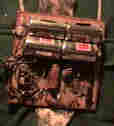 So named for its function of coupling the collected data directly to the mind of the researcher, this instrument all but eliminates hardware error, training time, and calibration. Most importantly, the collection of data in short bursts at random intervals, reduces the effects of the uncertainty principle since the observed phenomena is unable to change rapidly enough to affect the average reading.
So named for its function of coupling the collected data directly to the mind of the researcher, this instrument all but eliminates hardware error, training time, and calibration. Most importantly, the collection of data in short bursts at random intervals, reduces the effects of the uncertainty principle since the observed phenomena is unable to change rapidly enough to affect the average reading.
 Much of the basic research behind this instrument is based on work done in the early 1970's by
Dr. Gladstone during his invention of the 'Encephalostrap' - a headband that enabled 'no hands' manipulation of wet clay.
Much of the basic research behind this instrument is based on work done in the early 1970's by
Dr. Gladstone during his invention of the 'Encephalostrap' - a headband that enabled 'no hands' manipulation of wet clay.
 Since the CC is a self contained unit (it runs on six volts, provided by four D-cells), all readings must be verified. This is accomplished by outfitting a minimum of two observers, each with their own unit.
Since the CC is a self contained unit (it runs on six volts, provided by four D-cells), all readings must be verified. This is accomplished by outfitting a minimum of two observers, each with their own unit.

For obvious reasons many of the original pages of formulae were written backwards.

It is difficult to believe that this is coincidental.

The shape of the object is directly related to its compression coefficient.

The curve of the wall of the object defines unique vectors in the field effect when forces are applied.

Composition and strength are correlated and probably give rise to the term 'strong form' as it is used in the visual arts.

By-products of postfiring provide no useful data, since organic materials do not contribute to compression strength. Occasionally surface decoration will confuse readings.